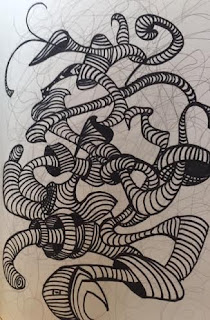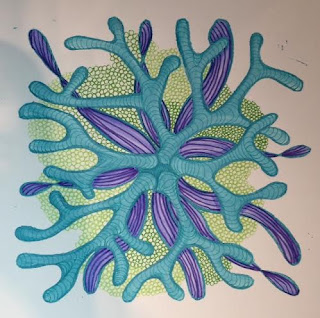Every time I see a cuttlefish, I think it should be looking for it's shell-home and that shell should look like a little Nautilus.....appropriate, I guess, since they are in the same family, genus, family, species in the biological sense. The cuttlefish does not appear to have scales, and looks soft and fleshy (although not slimy.) When I recently asked a S.C.U.B.A. diving friend if he had ever seen these on dives, he responded that he has occasionally seen little ones in the Mediterranean, but not the Gulf of Mexico.
The inspiration for this drawing is actually about 3 1/2 to 4 inches long. From the top of the snouty arms (8 of them in all) and tentacles (2 of them,) to the tip, it a max of 2 inches. A ruffle runs from behind one eye, all the way around the length of the body, and stops just behind the second eye. This ruffle is constantly furling and appears to be the propulsion and steering device all in one.
I know there are bigger varieties of the cuttlefish, but the largest I have seen in an aquarium is 4 1/2 inches in length. There is a flamboyant cuttlefish in the Tampa aquarium that is illuminated by black light and it is filled with neon highlights and bumps on a beautiful purple body. Structurally it look just like these beige, pink, and sandy-colored cuttlefish, however.
Cuttlefish have 4 types of body changes that are used in deliberate combinations, to communicate. These visible polyphenisms (body changes for communication,) are:
Chromatic - skin color
Textural skin rough or skin smooth
Posture
Locomotion
Of these 4 observed polyphenisms, there are 34 chromatic, 6 textural, 8 posture and 6 locomotion patterns in most observed cuttlefish and more in the flamboyant cuttlefish variety.
Flamboyant cuttlefish:
Chromatic 42 - 75 variations
Textural 7
Posturing 14
Locomotion 7
Three color patterns have also be documented:
Uniform
Mottled
Disruptive
Each cuttlefish can display one "message" on one side of the body and a different "message" on the other. Handy for courting a mate AND fending off a possible rival at the same time.
Cuttlefish sometimes use of these polyphenisms and patterning to signal future intent. For example, a male will adopt a zebra pattern on the body and a "dark face" when threatening to attack. A female can visually distinguish a male from a female and will only display "splotch" patterning to another female. She has a different color and patterning display when interested in mating and will only display to a male.
What interesting molluscs these are - know more than you wanted OR are you intrigued???















































